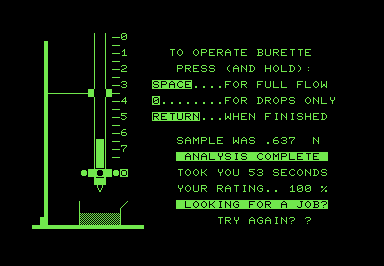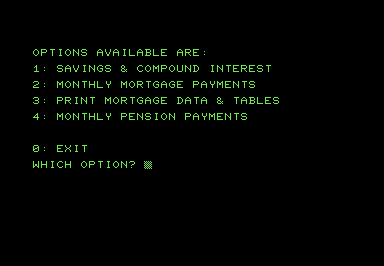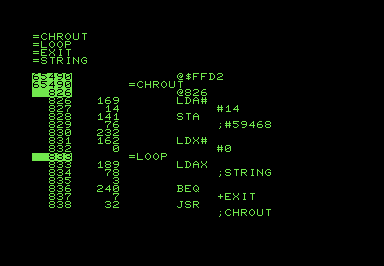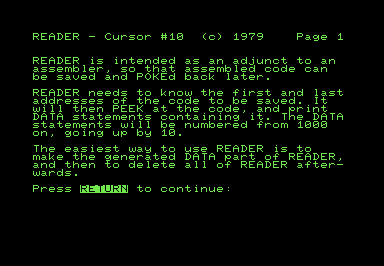CURSOR #10 – May 1979

COVER
Author: Uncredited
Original file name: COVER10!
PRG file: cover10.prg
This month features CURSOR’s second musical cover. The PET plays six short melodies in a loop while the display draws line graphs tracing the melodic contours of the tunes. "If you have a PET, and you don't have sound," says the flyer, "you are missing one of life's little pleasures."
Pressing SPACE takes you to the table of contents for the issue.

TITRATE
Author: Garry Flynn
Original file name: TITRATE
PRG file: titrate.prg
TITRATE is a titration simulation that plays out a bit like a timing game. Use the
keyboard controls to mix solutions and get an indicator to change colour. Go too far, and you ruin
the sample. The PET will rate your performance, and if you take too long, it will chide you for
being slow. A real scientist would probably prefer carry out titrations in a slow, deliberate
fashion so as not to waste samples, but then most scientists don't have have to answer to the PET
for their performance throughput.

FINANCE
Author: T. M. Wagner
Original file name: FINANCE
PRG file: finance.prg
FINANCE is a suite of financial calculators: compound interest, mortgage amortization,
and pension payouts. I'm not usually a fan of these antique financial calculators, but I could see
the mortgage estimator tool being useful in 1979. I put my own mortgage details in as a test and the
numbers came out they way I'd expect.

COURSE
Author: Glen Fisher
Original file name: COURSE
PRG file: course.prg
COURSE is a maze game: the PET throws a jumble of random PETSCII box fragments
onto the screen and your goal is to manoeuvre around the "obstacles" that result—using
the numeric keypad—and find a path from the home position to the bottom right corner of
the screen. This one's a fun diversion for a little while but is not deep enough to provide
much replay value.

ASM
Author: Glen Fisher
Original file name: ASM
PRG file: asm.prg
ASM is a simple symbolic assembler designed to use as little memory as possible.
The assembler recognizes the official 6502 opcodes, can handle decimal and hexadecimal values,
and allows for user-defined address labels and numeric constants. Not too bad for 8K with some
room left over for programming.
The assembly syntax is a little unusual but I get the impression that some of the conventions
we are used to today had not yet been standardized. You have to put your assembly instructions
into BASIC DATA statements which are then parsed by the program and POKEd
into memory. ASM comes with a sample program which you'll need to delete if you
want to start writing your own. Deleting these lines is a bit inconvenient; it would have been
nice to have been provided with a blank version of ASM.
The flyer comes with three dense pages of instructions, which you'll want to have handy as you get used to the syntax. I found the assembly process to be extraordinarily fussy and managed to crash the machine several times before I successfully wrote a simple ‘Hello, world!’ program in assembly language. I wrote my code on the 4016, so the message will appear as hELLO, WORLD! on the 2001.

READER
Author: Glen Fisher
Original file name: READER
PRG file: reader.prg
READER is a companion program to ASM. If you have a machine
language program already in memory, then you can use this utility to generate the
DATA statements needed to create a "BASIC loader" program for your code.
I ran READER on my ‘Hello, world!’ program and the
output
looks correct.
